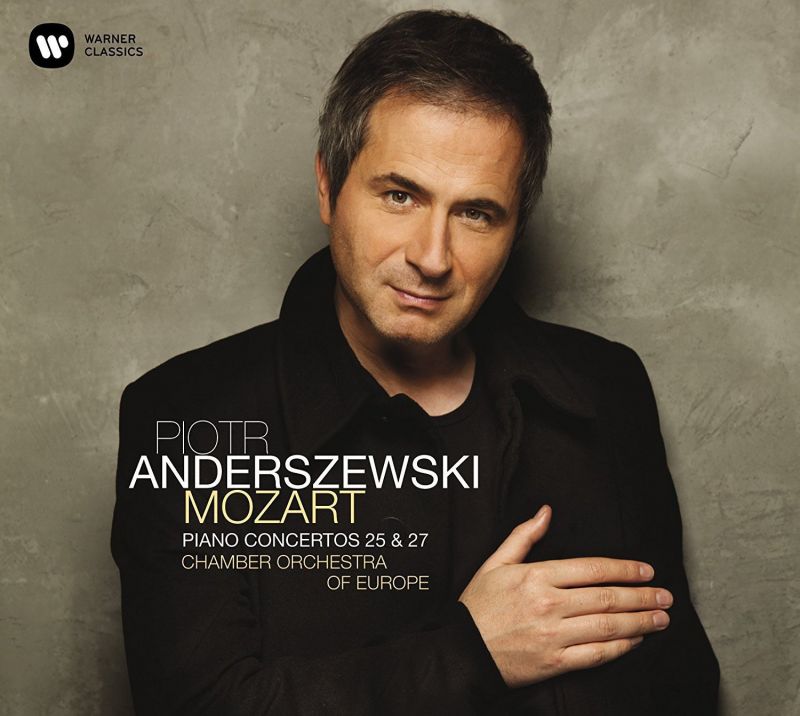MOZART Piano Concertos Nos 25 & 27
View record and artist detailsRecord and Artist Details
Composer or Director: Wolfgang Amadeus Mozart
Genre:
Orchestral
Label: Warner Classics
Magazine Review Date: 02/2018
Media Format: CD or Download
Media Runtime: 63
Mastering:
DDD
Catalogue Number: 9029 57242-2

Tracks:
| Composition | Artist Credit |
|---|---|
| Concerto for Piano and Orchestra No. 25 |
Wolfgang Amadeus Mozart, Composer
Chamber Orchestra of Europe Piotr Anderszewski, Conductor, Piano Wolfgang Amadeus Mozart, Composer |
| Concerto for Piano and Orchestra No. 27 |
Wolfgang Amadeus Mozart, Composer
Chamber Orchestra of Europe Piotr Anderszewski, Conductor, Piano Wolfgang Amadeus Mozart, Composer |
Author: David Threasher
Anderszewski habitually pairs a lyrical work with a more dramatic one: the ubiquitous C major, once indelibly associated with a Swedish film, versus the clarinet-imbued Sturm und Drang C minor, followed four years later by the serene G major, No 17, set against the agitated D minor, No 20 (5/06). Here it is the very last concerto – often described as ‘autumnal’ or ‘valedictory’, given its proximity to Mozart’s death (although it may have been started up to three years earlier) – prefaced by the triumphant C major work whose chief motif seems almost to quote the Marseillaise. These have often been thought to signal a departure from the quasi-operatic-ensemble construction of the run of concertos from the mid-1780s, moving towards a more discursive unfolding in K503 and a more simply songlike one in K595. Nevertheless, the wonderful playing of the Chamber Orchestra of Europe shows just how fully the earlier work, especially, is dominated by woodwind conversation and that it can’t be too distantly related to the sound world of Figaro’s ‘Non più andrai’.
Anderszewski’s piano is right there in the middle of it, supporting, chattering away in passagework, never once hogging the spotlight at the expense of his first-desk soloists, and pulling gently against the pulse to coax maximum character from the music without compromising its shapely contours. He is aware, too, of the delicate shading of these works, taking, for example, a minute and a half longer than Maria João Pires (with Abbado) over K595’s slow movement; the sense of awed stillness he achieves here contrasts with her comparatively playful approach, and Anderszewski’s studio conditions show off the COE more finely than the Orchestra Mozart, recorded in concert in 2011. Two years after that Pires performance, Martha Argerich revisited K503 with the same accompanists; Anderszewski is broader in all but the finale than the Argentinian and here provides his own first-movement cadenza, which matches the majesty of its surroundings while tweaking cheekily at the bounds of 18th-century harmonic propriety. (In the absence of a genuine Mozart cadenza for K503, Argerich uses one by her teacher Friedrich Gulda.)
There are so many moments here that bring a smile to a jaded Mozartian’s face: little holdings back, touches of ornamentation, that magical moment in K595’s slow movement where the piano’s song is shadowed only by flute and violins, exquisitely done here. You may be getting the impression that I rather like this record. I wouldn’t (couldn’t) go without recordings by other longtime favourite pianists (two of whom are invoked above); but then, Anderszewski is a favourite pianist too, and his coupling joins theirs without fear of compromise.
Discover the world's largest classical music catalogue with Presto Music.

Gramophone Digital Club
- Digital Edition
- Digital Archive
- Reviews Database
- Full website access
From £8.75 / month
Subscribe
Gramophone Full Club
- Print Edition
- Digital Edition
- Digital Archive
- Reviews Database
- Full website access
From £11.00 / month
Subscribe
If you are a library, university or other organisation that would be interested in an institutional subscription to Gramophone please click here for further information.




